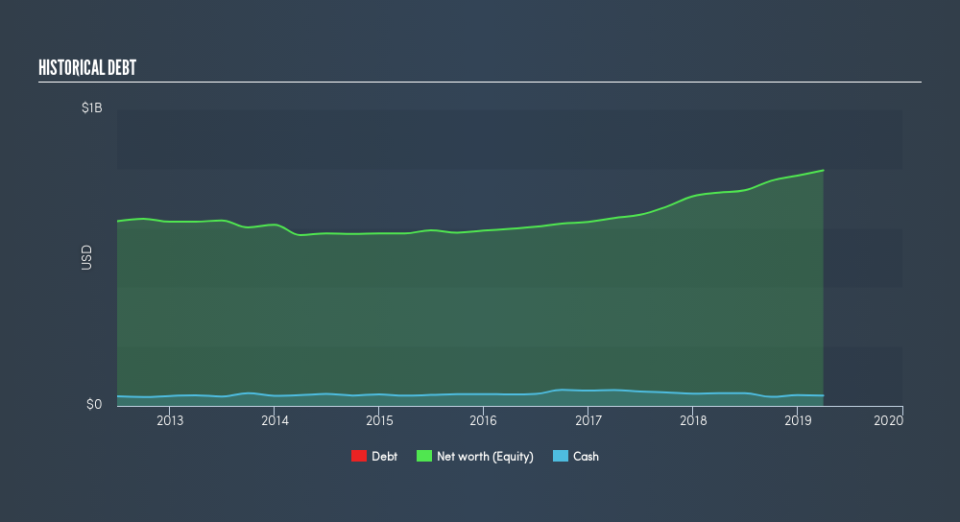ESCO Technologies Inc. (NYSE:ESE): Financial Strength Analysis

Want to participate in a short research study? Help shape the future of investing tools and you could win a $250 gift card!
Small-cap and large-cap companies receive a lot of attention from investors, but mid-cap stocks like ESCO Technologies Inc. (NYSE:ESE), with a market cap of US$2.0b, are often out of the spotlight. However, generally ignored mid-caps have historically delivered better risk-adjusted returns than the two other categories of stocks. This article will examine ESE’s financial liquidity and debt levels to get an idea of whether the company can deal with cyclical downturns and maintain funds to accommodate strategic spending for future growth. Note that this commentary is very high-level and solely focused on financial health, so I suggest you dig deeper yourself into ESE here.
See our latest analysis for ESCO Technologies
Does ESE Produce Much Cash Relative To Its Debt?
ESE has shrunk its total debt levels in the last twelve months, from US$290m to US$217m , which also accounts for long term debt. With this debt payback, the current cash and short-term investment levels stands at US$35m , ready to be used for running the business. Moreover, ESE has generated cash from operations of US$77m in the last twelve months, resulting in an operating cash to total debt ratio of 35%, meaning that ESE’s current level of operating cash is high enough to cover debt.
Can ESE pay its short-term liabilities?
At the current liabilities level of US$202m, the company has been able to meet these commitments with a current assets level of US$436m, leading to a 2.16x current account ratio. The current ratio is the number you get when you divide current assets by current liabilities. For Machinery companies, this ratio is within a sensible range as there's enough of a cash buffer without holding too much capital in low return investments.
Does ESE face the risk of succumbing to its debt-load?
ESE’s level of debt is appropriate relative to its total equity, at 27%. This range is considered safe as ESE is not taking on too much debt obligation, which can be restrictive and risky for equity-holders. We can check to see whether ESE is able to meet its debt obligations by looking at the net interest coverage ratio. A company generating earnings before interest and tax (EBIT) at least three times its net interest payments is considered financially sound. In ESE's, case, the ratio of 13.42x suggests that interest is comfortably covered, which means that lenders may be less hesitant to lend out more funding as ESE’s high interest coverage is seen as responsible and safe practice.
Next Steps:
ESE’s high cash coverage and appropriate debt levels indicate its ability to utilise its borrowings efficiently in order to generate ample cash flow. Furthermore, the company will be able to pay all of its upcoming liabilities from its current short-term assets. This is only a rough assessment of financial health, and I'm sure ESE has company-specific issues impacting its capital structure decisions. I recommend you continue to research ESCO Technologies to get a more holistic view of the stock by looking at:
Future Outlook: What are well-informed industry analysts predicting for ESE’s future growth? Take a look at our free research report of analyst consensus for ESE’s outlook.
Valuation: What is ESE worth today? Is the stock undervalued, even when its growth outlook is factored into its intrinsic value? The intrinsic value infographic in our free research report helps visualize whether ESE is currently mispriced by the market.
Other High-Performing Stocks: Are there other stocks that provide better prospects with proven track records? Explore our free list of these great stocks here.
We aim to bring you long-term focused research analysis driven by fundamental data. Note that our analysis may not factor in the latest price-sensitive company announcements or qualitative material.
If you spot an error that warrants correction, please contact the editor at editorial-team@simplywallst.com. This article by Simply Wall St is general in nature. It does not constitute a recommendation to buy or sell any stock, and does not take account of your objectives, or your financial situation. Simply Wall St has no position in the stocks mentioned. Thank you for reading.

